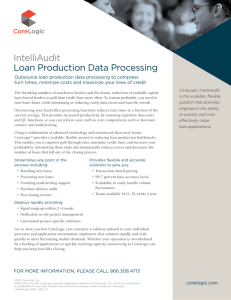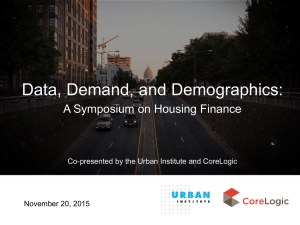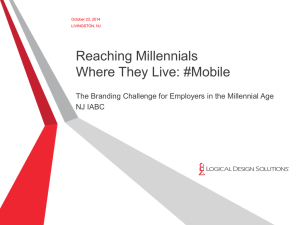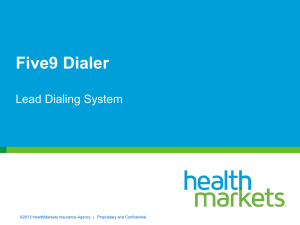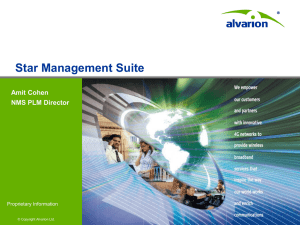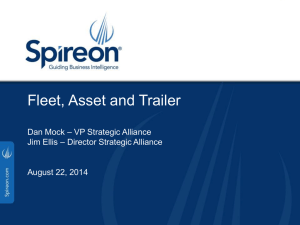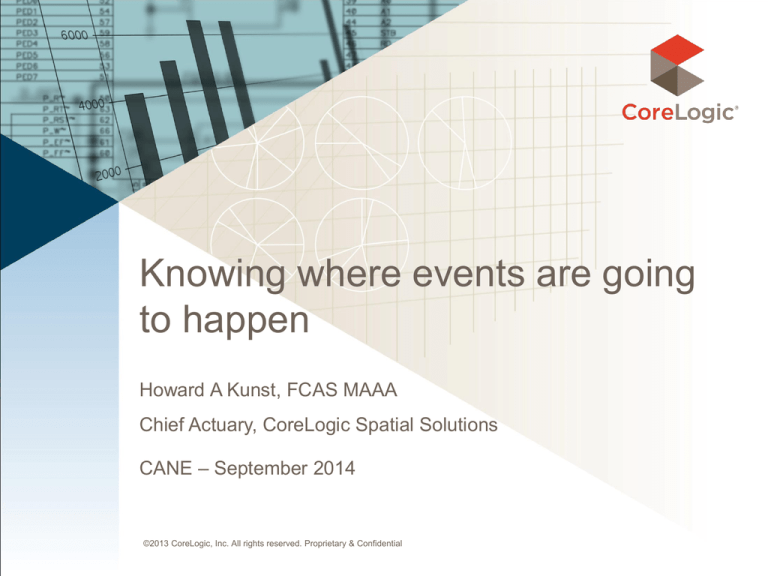
Knowing where events are going
to happen
Howard A Kunst, FCAS MAAA
Chief Actuary, CoreLogic Spatial Solutions
CANE – September 2014
©2013 CoreLogic, Inc. All rights reserved. Proprietary & Confidential
Antitrust Notice
The Casualty Actuarial Society is committed to adhering strictly to the letter and
spirit of the antitrust laws. Seminars conducted under the auspices of the CAS
are designed solely to provide a forum for the expression of various points of
view on topics described in the programs or agendas for such meetings.
Under no circumstances shall CAS seminars be used as a means for
competing companies or firms to reach any understanding –expressed or
implied – that restricts competition or in any way impairs the ability of members
to exercise independent business judgment regarding matters affecting
competition.
It is the responsibility of all seminar participants to be aware of antitrust
regulations, to prevent any written or verbal discussions that appear to violate
these laws, and to adhere in every respect to the CAS antitrust compliance
policy.
©2013 CoreLogic, Inc. All rights reserved. Proprietary & Confidential
Session Objectives
What determines the short term vs long term frequency?
Geographical accuracy
Models predict where the events are more likely to occur
Geocoding accuracy – understanding granular data
Validation of recent history of events
Hail
Tornado
Wildfire
Combination of multiple perils – Single Risk Score
©2013 CoreLogic, Inc. All rights reserved. Proprietary & Confidential
3
Understanding where events can happen
What affects the short term frequency of events?
Climate change – frequency of events and geographic distribution
Solar activity
Heat – sunk in the earth, stored in oceans
Drought conditions / Abundance of precipitation
Time elapsed since last event
Random variation
It’s almost impossible to predict exactly when and where the next
event is going to happen
But if you can predict the locations with the highest risk for an event, isn’t
that just as much or more important for setting a natural catastrophe
plan/strategy?
©2013 CoreLogic, Inc. All rights reserved. Proprietary & Confidential
4
Knowing where events are going to happen
Scientists gather information on the both short/long term factors that
increase/decrease the likelihood of natural catastrophic events
Models are developed that set a risk level for every location across
the US – extremely granular (10 meter grids)
Revisions are made annually to adjust for more recent information
(ie vegetation changes / drought conditions for Wildfires)
Ongoing validation on the accuracy of the models by comparing
where recent events have occurred to the estimated risk levels
Do the actual events in fact occur in the higher risk areas that we
expected?
©2013 CoreLogic, Inc. All rights reserved. Proprietary & Confidential
5
The importance of granularity
What is Parcel Data?
Parcel boundary data represents the
legal extents of each taxable U.S.
property address.
There are an estimated 145 million
privately owned parcels in the U.S.
CoreLogic has converted and normalized
about 140 million parcels from state,
county, city, and town sources
As these digital parcel boundaries
become available they are rapidly being
incorporated into applications to
enhance:
o
o
o
o
Geocoding accuracy
Risk assessment
Risk concentration
Many other uses where “granular” accuracy is
important
©2013 CoreLogic, Inc. All rights reserved. Proprietary & Confidential
Wildfire Risk Determination
Data Elements
Data Granularity
Digital Elevation Model (DEM)
Satellite Imagery
Vegetation Condition Class data
Condition
Class
Fuel
Fuel
Load
Vegetation
20% of Total
Risk
80% of Total
Risk
Wildfire Risk
Aspect
Topography
Slope
Input cell size based on 30m grid
All layers sampled at 30m
©2013 CoreLogic, Inc. All rights reserved. Proprietary & Confidential
Composition
Class
Aspect
Slope
Wildfire Risk
NC QL2 LiDAR (2014)
River
Floodplain
Floodplain
QL2 nearly mirrors existing
high precision survey data
QL2 – 0.3m Profile
Actual
Survey Elevations
©2013 CoreLogic, Inc. All rights reserved. Proprietary & Confidential
Severe Convective Storms (SCS)
Severe Convective Storms (SCS) refer to Tornado, Hail and
Straight Line Wind events
Prior to recent events, less attention given to SCS vs Hurricane and
Earthquake
Tornados and the storms that generate tornados account for more than
half of the insured catastrophic losses (57%) that occur each year in the
U.S. – and extend beyond “Tornado Alley”
Frequency of observed events has increased
Growing population
Better observational tools (Doppler radar, etc.)
Rising global temperature?
©2013 CoreLogic, Inc. All rights reserved. Proprietary & Confidential
9
©2013 CoreLogic, Inc. All rights reserved. Proprietary & Confidential
10
Distribution of 2”+ Hail events
52.4% of Damaging Hail events occur in areas with Extreme
Hail Risk levels
85.6% of Damaging Hail events occur in areas of High, Very
High or Extreme Hail Risk; those areas are only 40.7% of the
land area of the USA.
©2013 CoreLogic, Inc. All rights reserved. Proprietary & Confidential
11
©2013 CoreLogic, Inc. All rights reserved. Proprietary & Confidential
12
Annual EF0-EF5 Tornadoes
©2013 CoreLogic, Inc. All rights reserved. Proprietary & Confidential
13
Distribution of F2 and above Tornado events
30.3% of F2 and higher events occur in areas with Extreme
Tornado Risk levels
84.3% of F2 and above events occur in areas of High, Very High or
Extreme Risk; those areas are only 40.0% of the land area of the
USA.
©2013 CoreLogic, Inc. All rights reserved. Proprietary & Confidential
14
Overview - CoreLogic Wildfire Hazard Risk
Report
Drought conditions (only 5 states in the western U.S. recorded
precipitation at or above average in 2012) and high temperatures
impact the number of wildfires
67,664 Wildfires in 2012
9,326,000 acres burned in 2012
For 2000-2008, on average over 2,500 structures destroyed each
year, compared with less than 1,000 per year for all prior decades
Over 1,260,000 residential properties in the western U.S are
currently located in High or Very High Wildfire risk areas, with a
value of more than $189 billion
©2013 CoreLogic, Inc. All rights reserved. Proprietary & Confidential
15
Wildfire – Bastrop County, TX
©2013 CoreLogic, Inc. All rights reserved. Proprietary & Confidential
16
Wildfire – Bastrop County, TX
Wildfire – Bastrop County, TX
©2013 CoreLogic, Inc. All rights reserved. Proprietary & Confidential
17
Wildfire – Bastrop County TX
% of properties damaged increases with Wildfire Risk Score
Damage % varies across Very High Risk scores, but increasing
Wildfire Risk Score summary
WF Score
Scores 0-50
scores 51-60
scores 61-70
scores 71-80
scores 81-90
scores 91-100
Total
Total
properties
3,328
1,089
2,151
3,180
5,302
1,781
16,831
% in group
w/ damage
0.0%
0.6%
1.5%
7.2%
15.8%
18.7%
8.5%
% of properties damaged or destroyed, by WF score
20.00%
18.70%
18.00%
15.80%
16.00%
14.00%
12.00%
10.00%
7.20%
8.00%
6.00%
4.00%
1.50%
2.00%
0.00%
0.60%
0.00%
0-50
©2013 CoreLogic, Inc. All rights reserved. Proprietary & Confidential
51-60
61-70
71-80
81-90
91-100
18
Hazard Risk Score Summary
©2013 CoreLogic, Inc. All rights reserved. Proprietary & Confidential
19
Summary
There is an increasing number of events over the past decade
Location of recent events seem to follow where the models predict
they will occur
Hail and Tornado damage extends and causes damage beyond just
the traditional Tornado Alley
©2013 CoreLogic, Inc. All rights reserved. Proprietary & Confidential
20

